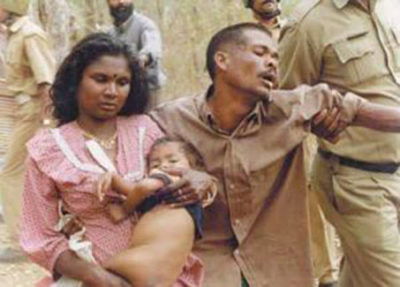From Muthanga to Madhu:The plight of Adivasi communities in Kerala
The miserable life of Adivasi communities of Kerala clearly shows the hypocrisy of the state that claims highest literacy and better health indices.
Recently Kerala witnessed various movements and agitations contiguous to the issues of Adivasi community of the state. Beginning with the death of Madhu, the starving tribal youth of Attappadi being murdered with an allegation that he had stolen rice, to the recent strike in the state against the amendment of the SC/ST atrocities Act, all the agitations are ignored at a fast pace. The issues of Adivasi communities in Kerala cannot be seen through a single lens. It ranges from health issues, encroachments, illiteracy, unemployment, human rights violation and the list goes on.
 The independent governments from time to time have failed in acknowledging the land rights of Adivasi communities and restore forest land and their right to self-governance. Professor Nithya N R of Kerala University has rightly pointed out that “As the government remained indifferent, the Adivasi communities have from time to time tried to assert their land rights but were brutally crushed by unleashing the state violence as at Cheengeri, Muthanga and Chengara”.
The independent governments from time to time have failed in acknowledging the land rights of Adivasi communities and restore forest land and their right to self-governance. Professor Nithya N R of Kerala University has rightly pointed out that “As the government remained indifferent, the Adivasi communities have from time to time tried to assert their land rights but were brutally crushed by unleashing the state violence as at Cheengeri, Muthanga and Chengara”.
Muthanga movement stands as an important struggle in the history Adivasi movements in Kerala. It was much beyond an organised movement to restore the land rights of the Adivasi communities of the Wayanad district of Kerala. It was a culmination of various issues of encroachments on Adivasi land across the state, the deaths due to malnourishment in Attappadi and the ongoing human rights violation towards these indigenous people.
The analysis of various forest policies and Acts show that Adivasi communities were denied their rights at every stage of history. As A Damodaran identifies “The major problem in the Wayand crisis was the existence of draconian forest laws in connection with the improperly structured developmental programs”.
The forest laws enacted in the colonial period specifically, the Forest Acts of 1865 and 1878 made government the single stakeholder of the forest which turned to be disadvantageous for the tribal communities.
The Indian Forest act of 1927 (IFA) also strengthened the state control over the forest lands. Along with it, initiation of wildlife protection act was also a blow to the rights of Adivasi communities. The Wayanad forests were declared as reserved forest and a working plan for the same was implemented in 1902. This has endangered the livelihood of the Adivasis. Wayanad was declared as a wildlife sanctuary in 1973. The Indian Forest Act of 1927 and Wildlife Protection of policy of 1972 resulted in neglecting the land rights of tribal population in Wayanad.
 For Adivasis, the right to land is highly associated with their livelihood. This coincided with the growth of bonded labour and the emergence of moneylenders in the region. When the land reforms were initiated in the state, the settled agricultural laborers in the forest regions were given the ownership of land. The Adivasis, thus, were devoid of the land and did not have any documents to prove their rights over the land.
For Adivasis, the right to land is highly associated with their livelihood. This coincided with the growth of bonded labour and the emergence of moneylenders in the region. When the land reforms were initiated in the state, the settled agricultural laborers in the forest regions were given the ownership of land. The Adivasis, thus, were devoid of the land and did not have any documents to prove their rights over the land.
The 1975 Act of Scheduled Tribes (Restriction on Transfer and Restoration of Alienated Lands Act) could not do justice to these people as the act demanded the Adivasis to pay for the restored land which were once their own land. In 1999 Kerala government passed an amendment Act to the 1975 land Act. The real motive of the law was to help the encroachers and provide the Adivasis with alternative land instead of the alienated land. Following the starvation death in Attappadi in Palakkad district of Kerala, the Adivasis were in constant agitation with the government. Hence, the government in 2001 entered into a pact with the Adivasis who were demanding the implementation of 1975 Act and the inclusion of Adivasi areas under the Schedule V of the Indian constitution.
The delay and discrepancies in the implementation of the pact resulted in Adivasi resistances culminated in the Muthanga struggle of 2003. The Adivasi communities of Wayanad had laid siege to the wildlife sanctuary at Muthanga under the leadership of Adivasi Gotra Maha Sabha.
During the struggle, without prior notification people were attacked by state and violent measures were taken to evict the Adivasi groups from Muthanga forest range. The Adivasis failed in the movement and suffered a lot. But they were branded as criminals by the state and were charged with many cases including Naxalism. The state and its police who committed brutal human rights violation were protected in the court. The people who fought for their rights were branded as criminals and are still facing the criminal proceedings in the court.
The unanswered questions and unresolved issues of Adivasis in Kerala are giving ways to numerous episodes of human rights violation. The literate and educated civil society of Kerala has the moral and political obligation to ensure that yet another episode of Muthanga, Attappadi death series and murder of another Madhu should not happen again.
